Art Tools of Ivica Stevanovic
We're glad to have with us Ivica Stevanovic for this interview. He's an illustrator, comic artist and graphic designer from Serbia.
His artworks are very textural, character designs are more towards to the dark side and are wonderful, and he has works published in several books. He uses pen and ink, watercolour and digital painting.

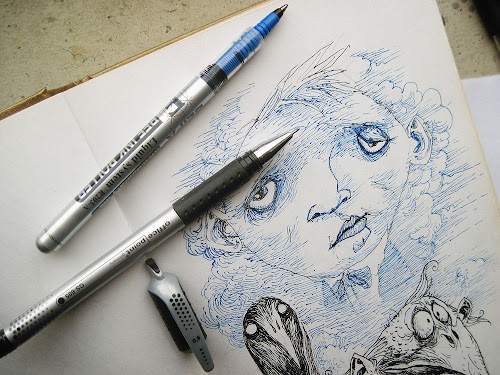
Qn: Let's talk about the pens you use. What are the two pens above? What are their characteristics?
These are pencils with ink gel, one black and the other blue.
When I do a line drawing (without gray tones) usually combines gel ink pens of different colors. In that way I can suggest plans or accents of certain elements in the drawing.
These pens are of medium quality, in the level of office supplies. I prefer Office Point by German producers, because beginning use of this pen gives a very fine and slender line. Over the time, pen's gel ink melts and lines become thicker and greasier, but the pen is still very useful (especially for expressive drawing)...
When I draw on a smooth paper, the traces/lines that remain can be washed by water, but when it dries is a pretty waterproof (especially when it draws on some absorbent paper).

Qn: And how about these two? What's the difference between this pen and the one you mentioned earlier? Is the drawing beneath drawn with the pen? The ink does not look very black.
This pen is of little lower quality. Gel ink is not so intense, and the lines are dashed - it is difficult to achieve uniform continuity of the drawn line. But I love art supplies with disabilities, because I always give them a specific purpose ;)
Qn: What's that brush pen or water brush? What's the ink inside? Do you like working with it?
I use brush pens (water brushes) sometimes. They are very helpful for the sketching trips. I usually use two brush pens, which I filled with diluted ink to get two shades of gray tones – one lighter, the other darker.
Czech school ink (Koh-I-Noor) is quite good for using in the water brush tank – I do mix it with water in order to get shades of gray. Although it is a school ink, it is very good, and waterproof. Lately, more and more I draw with Dutch Indian ink (Talens).
At the start of work, I first use this brush pens for basic setting drawings, combining lighter and darker gray values. Then I draw precise and delicate lines with gel ink liners or nibs over the gray tones, so I get the impression of fullness and volume of shapes and forms in the drawing ...

Qn: Can you tell us about the dip pens that you're using? When do you choose to use these nibs versus the normal pens? Do you usually use one dip pen for the job or several for one job?
I've used dip pens for a long time. I love to draw with nibs. Earlier, as a kid I used Rapidograph pens. But multiliners and gel ink pens cannot create such tactile, adorable, velvety and rich line compared to nib pens.
Dip pens possess sensitivity, flexibility, softness, firmness... everything that can wish for an artist.
Nibs are a powerful weapon in the hands of artists and illustrators, it can express poetic and dramatic lines at the same time. That's why I love them so much.
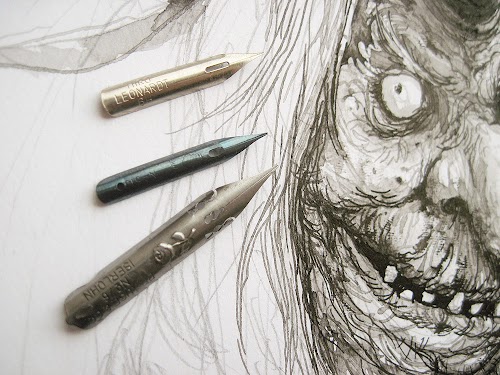
Qn: What should one take note of when using dips pens?
I think it's very typical to artists who like the details, they often use nibs as a drawing kits.
In my arsenal you can find a wide variety dip pens — from softest and thinnest pens that give thin lines like cobwebs, to hard and firm pens that give thicker and strong lines. Using different nibs can create fantastic richness lines in the drawing.
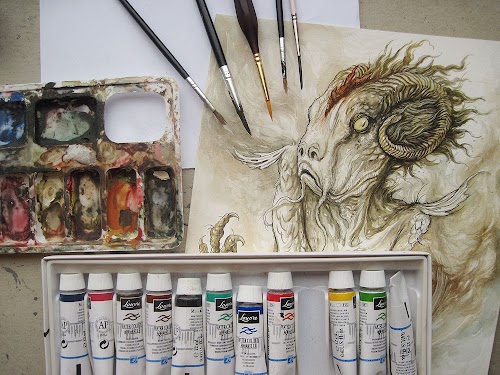
Qn: What watercolours do you use? Do they work well with your line art?
I use French watercolors Louvre (Lefranc & Bourgeois) for their reasonable price and solid quality. They have a nice color intensity — not too strong (as the Russian colors that I had a chance to use). The colors are fine for me, since I rarely use intensive colored tones in my illustrations.
Qn: In your mixing palette, I see a well that has a lot of deposits and the one next to it is spotless clean. What's going on there?
This white spot is actually a hole in the palette. It can be useful – to below the hole you can set a different colored backgrounds in order to better determine the intensity of mixed colors.
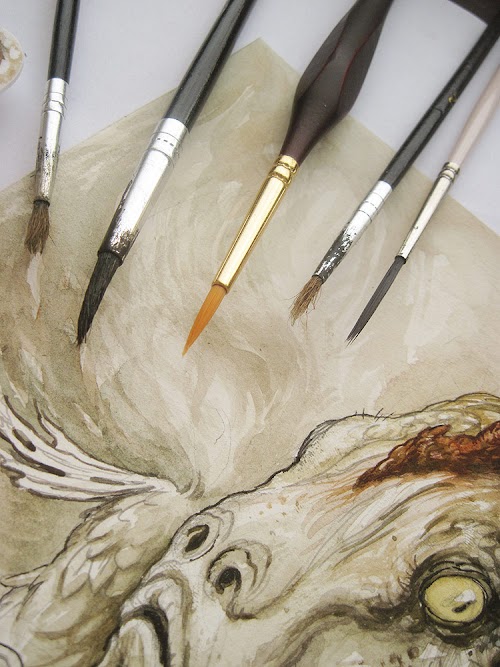
Qn: Can you give us a rundown on the brushes you use? I see two brushes with sprayed hair. The middle brush is quite interesting with the big handle. Are there some brushes for inking?
Brushes with sprayed hair are very nice for watercolor painting. They can be made very spontaneous for creating transparent colored surfaces because of the messy and sprayed hair.
Spontaneity gives a specific impression of exempted forms and freshness in the watercolor painting. The spontaneous and free surfaces that I get, I reshape them with fine lines, and for that I use a brush-liners (brushes with pointed hair - for inking good as well).

Qn: I found this artwork on your blog. What did you use to create it?
My illustration Frankenstein's monster is the result of experimentation with artistic techniques (digital collage). Basic drawing was crated by pen and Indian watered ink, and then upgraded with various textures and parts of old engravings (similar to Dore's graphics).

Qn: Do you do digital painting often? What do you use?
It depends on what I'm doing. Some projects inspire me to illustrate using the technique of digital painting. A picture of the subject in my head guides me — If I imagine a digitally painted picture, then it will be so.
Most often, I make a drawing in a classical way with pen and ink. Then I scan it and paint digitally. When I digitally paint, I like to use a Photoshop brushes with a dry texture or Corel Painter brushes that imitate oil painting. And when I want my illustrations to have a weird photographic and "ready-made" atmosphere, I use the technique of digital collage, and image manipulation.
Qn: Who else do you think we should feature next?
I would recommend two of my friends and colleagues – Dragan Bibin and Petar Meseldžija. Also, I think it would be a very interesting interview with talented artist Joao Ruas about his artistic tools.
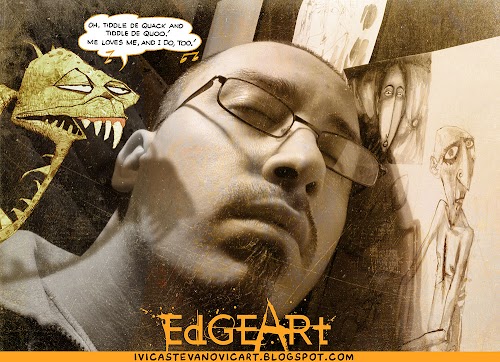
Thanks. That's all from Ivica Stevanovic.
You can see more of his artworks at
https://ivicastevanovicart.blogspot.com
https://www.behance.net/IvicaStevanovic
Comments?
Send them directly to Ivica Stevanovic at https://ivicastevanovicart.blogspot.sg/2014/02/interview-on-parka-blogs…
Items mentioned may be available at Dick Blick Art Materials, Amazon.com and Amazon.co.uk


